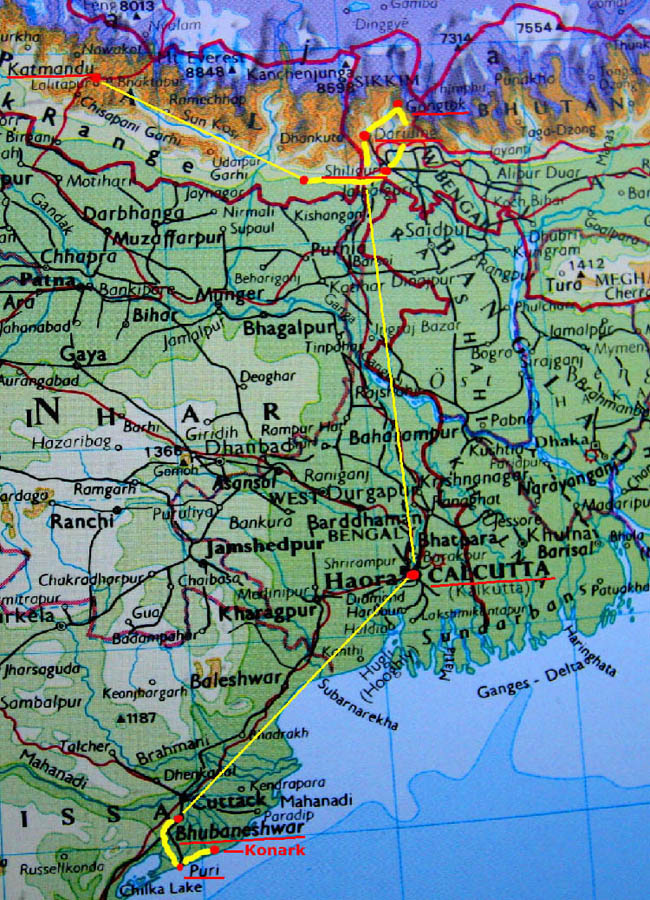Introduction
This is an abridged description of a trip through a part of northern India (see map below) commencing November 1992. The intention is to give a firsthand personal experience of how we, Brigitte and I, did get to and through the country. Despite the fact that I did not book anything in advance at all (except for the flights) and that we covered almost 1800km within the country during the 18 days, it was no problem getting any means of transport or accommodation on the same day. I only did some kind of pre-planning in so far that we wanted to be in Calcutta at least a couple of days before our flight back to Germany via Dhaka.
At the time of writing all this, more than 18 years have passed. What I had seen and experienced, may not be the way today anymore, but the Indian cultures and customs do not actually change rapidly despite our global world.
What definitely has changed are names, locations and prices of accommodations and restaurants, thus they will not always be mentioned.
Getting from Germany to Sikkim
We didn't come directly from Germany but went to Nepal first (see previous travel report), but our return flight did start from Calcutta via Dhaka again. So there also would have been the possibility to travel the other way around. My friend Manfred visited Sikkim in November 2009. He bought a ticket via Delhi to Bagdogra, 12km west of Shiliguri.
Coming from Nepal we arrived in Shiliguri late in the evening. The driver dropped us off at a guesthouse almost in the middle of town. But that didn't suit Brigitte. So the guy of the accompanying couple and I organized a taxi (was not easy) to drive to the best (according to the guidebook) hotel some place up a hill (forgot the name, maybe it was Hotel Manila).
That hotel looked a bit like a maharaja's place und thus was too plush with hiding places for all kinds of mites, etc. and the smell of an overdose of chemical bug killer all over the carpets and sofas. Even my bronchial tube was challenged. Then Brigitte remembered that our previous guesthouse had no plush and carpets. Ok, then let's go back. All of a sudden, the taxi driver doubled his fare. After showing him that we also could walk, even with our backpack, he gave in and finally we checked into the guesthouse we had arrived in the first place.
After a good night's sleep with no allergic or asthma reaction we boarded a bus going to the Sikkim border next morning just around 50km to the north.
Sikkim
We already had a permit to enter Sikkim, so we just did get a stamp in our passport at the border and then continued our trip for around another 50km until we reached Gangtok, since mid-19th century the capital of Sikkim. That was around the time when the British annexed all of Sikkim, which till then was part of a Tibetan kingdom. In 1947 Sikkim became part of India after it became independent (like so many other independences: what belonged to Britain belongs to us, India, now, the new imperialists).
We had to look for a hotel first. The Royal Palace standing on a hill has not become a hotel, yet. So we checked into one with a nice view down to the market and the valley. It looked very small from the front with just one story. We wondered when we were told to take the elevator to get to our rooms: it didn't go up but a couple of stories down. Almost whole of Gangtok is located at a ridge: one side the hill (with the palace) and the other side the river deep down.
Click the small picture to get it enlarged
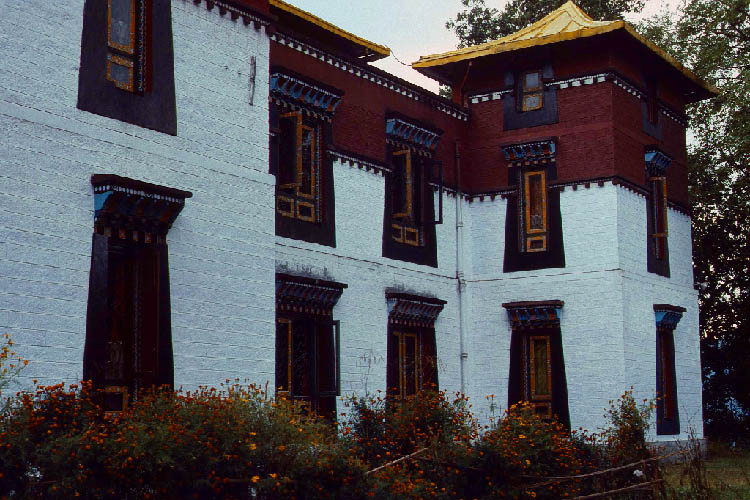
| We would have liked to stay here. No deal
|
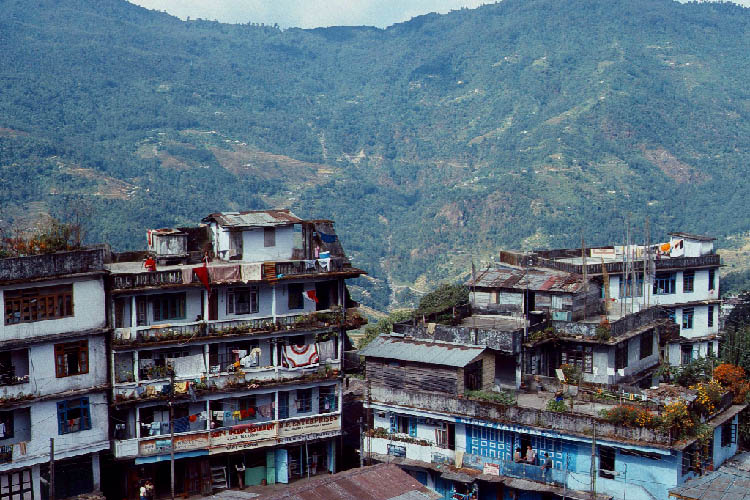
| But this is the view from our four story hotel
|
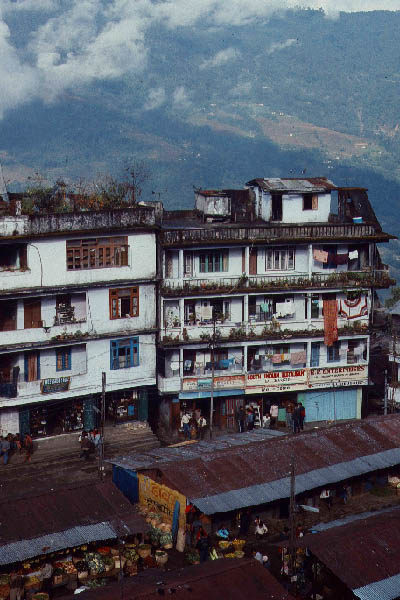
| That's the middle with the market of Gangtok
|
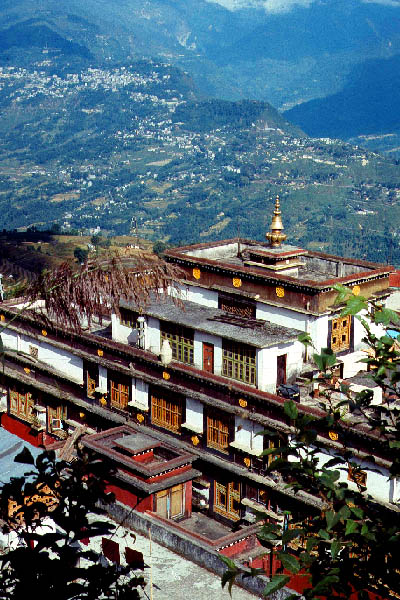
| But we are rather here for the Buddist culture
|
Gangtok itself has not much to offer, so we had to take a trip to the surrounding countryside with some monasteries scattered around. The most famous one is the huge Rumtek Dharma Chakra Centre. It's the official seat of the head of a Tibetan Buddhism order, but the head, called Karmapa, is not allowed by the Indian Government to take up his seat (check the reason and the latest information in the internet at www.rumtekmonastery.com). The same what the Chinese did to the Dalai Lama.
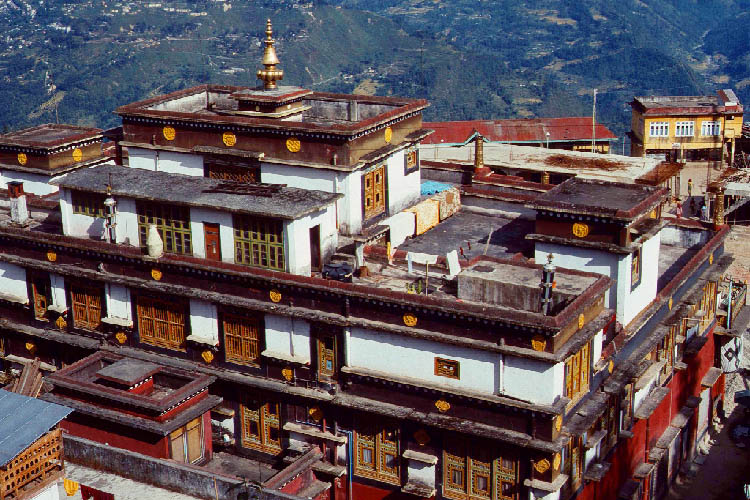
| The famous Buddhist Monastery
|
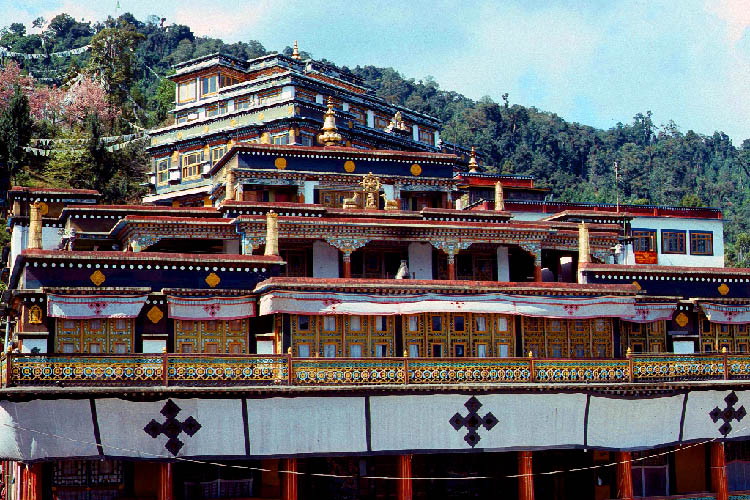
| At a slope of a hill at Rumtek
|
This center hosts many religious festivals, but unfortunately there was no one going on. So we only looked around and watched the monks studying, praying and playing.

| Young monks must learn
|
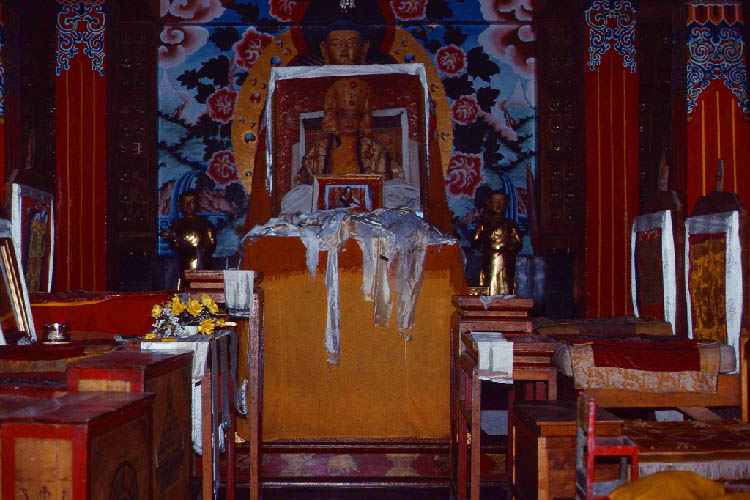
| Inside an altar to pray
|

| Young monks are playing
|
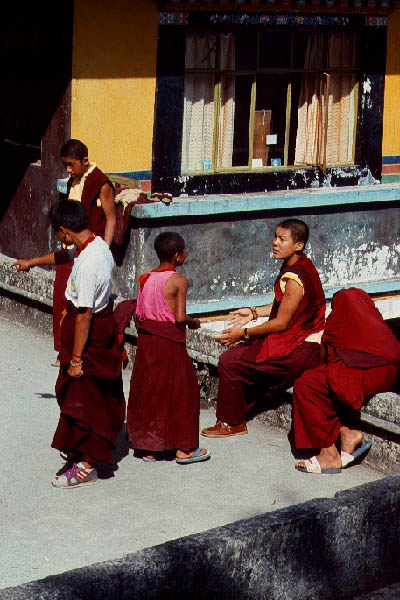
| like kids everywhere
|

| Or praying to Buddha
|
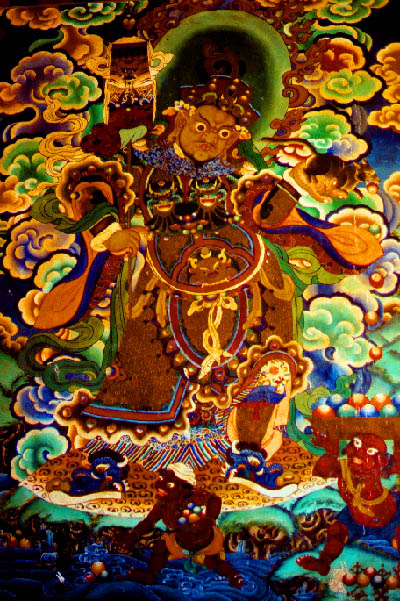
| to chase off the Demon?
|
What looks like laundries hanging around on top of the hill are actually cloths or flags with prayers printed on it to chase off the demons, who are supposed to fly all around. We did not see any but neither did we have a 360 degree sight around.
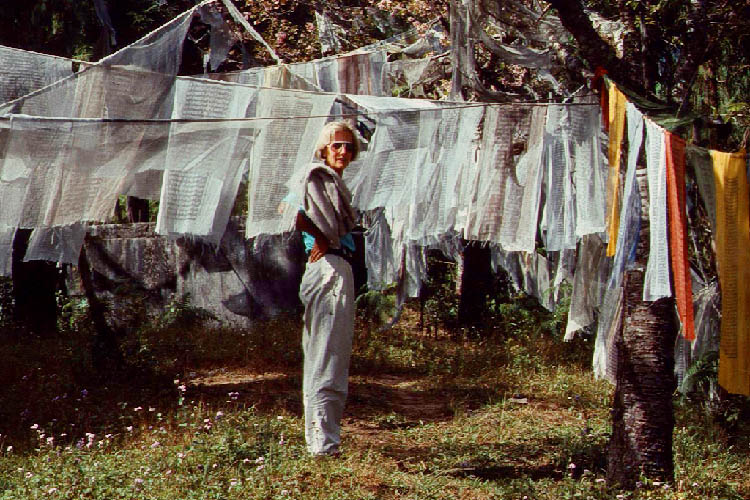
| This is also to keep demons away
|
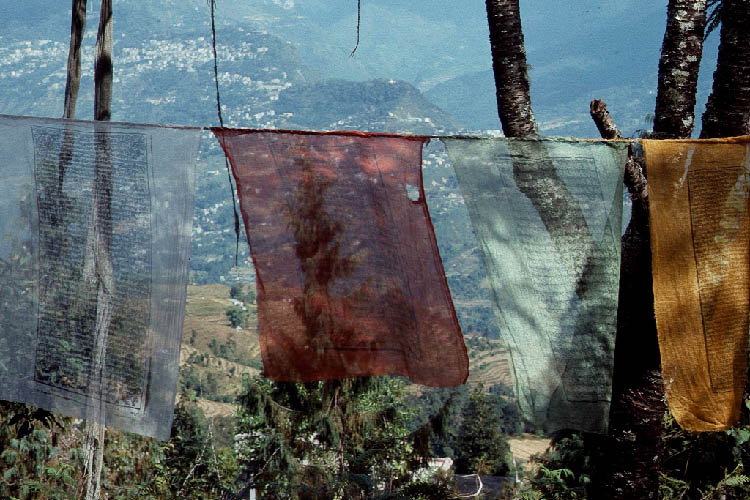
| with many stories written on cloth
|
And we could not see far either because of the misty weather. And that weather was unpredictable and also unstable over the last centuries. And that was actually what our accompanying couple wanted to find out. They drilled into the trees to take samples in order to determine from the tree rings the history of the weather. Not to prove that there were already climate changes on earth before, but to compare the samples with the ones they already took from trees in Germany, which they used to estimate the age of wooden artifacts or antique building materials.

| This is the landscape of Sikkim in bad weather
|
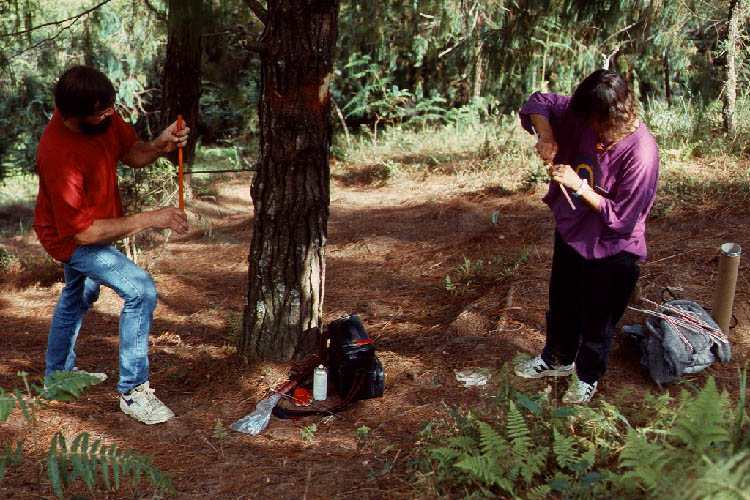
| This couple is taking tree rings to research the weather
|
The countryside looked similar to our northern Europe, even the fauna with a deer, but not the red leave Christmas flower as such known in Germany to be only grown in a pot and sold during Christmas time.
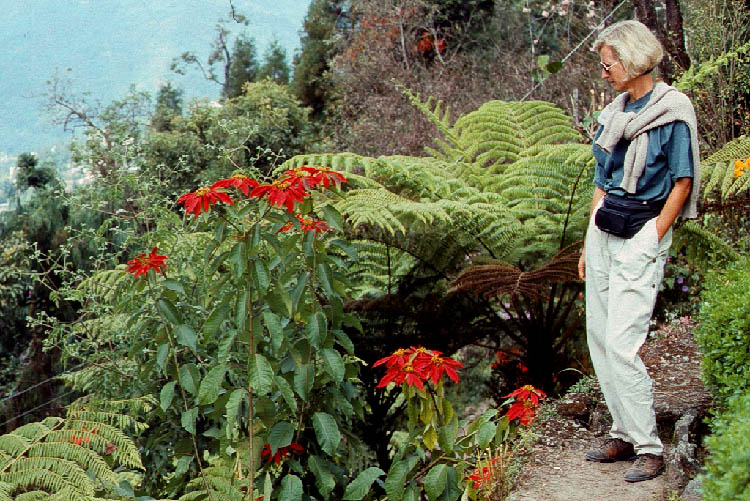
| Some plants are thriving in this climate
|

| Even deer you can find here
|
We didn't go on a trek in the Khangchendzonga National Park not to mention to climb up to the highest peak with 8598m. We had no gear and no more time, because we had still a long itinerary ahead of us (Brigitte didn't have to pass the mountaineering test but still the Calcutta-Test). After a last glimpse at the Khangchendzonga we left Sikkim on a bus to our next destination.
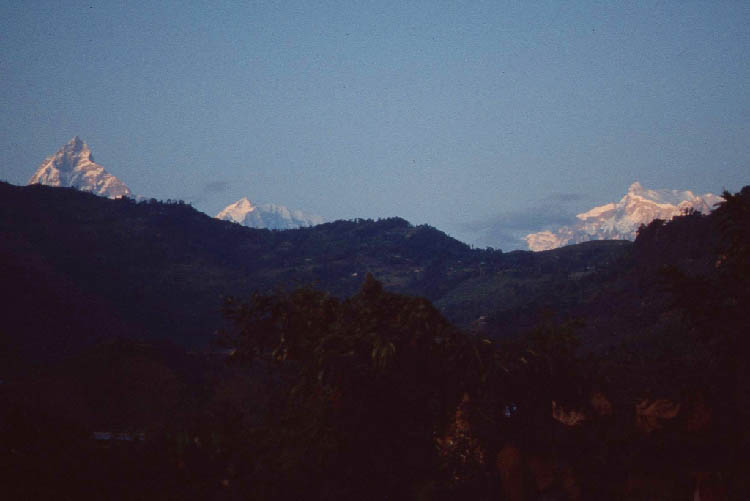
| Over there you see the Khangchen-dzonga
|
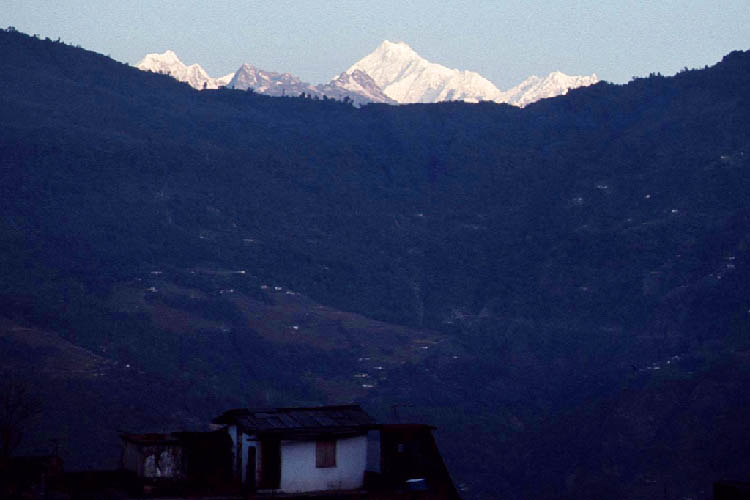
| Nothings grows there anymore
|
Darjeeling
The bus trip to Darjeeling was quite a ride. The sight around the countryside was alright. Also looking to the road through the rusty hole underneath my seat. After we survived the ride we wanted to enjoy life so we stayed at the famous
Windamere Hotel
Darjeeling, India
Tel: 2841 or 2397
|
We were lucky that they had a room available. The daily rate was around 100 USD per day for two including meals. What a good deal. Also the "room" consisted of two rooms: a living room and a separate bedroom, both with a fireplace, which were started by a boy some time before sunset to get it warm just in time for the evening. In addition we were supplied with hot bottles in the bed before we were supposed to sleep. And all this was really needed, because it was getting below zero centigrade during the night.
Yes, we also had a bathroom with a vintage flush toilet, which was almost 100 years old. I could not get behind the secret how to flush, though. The house boy demonstrated it to me how it works: with an elegant pull.
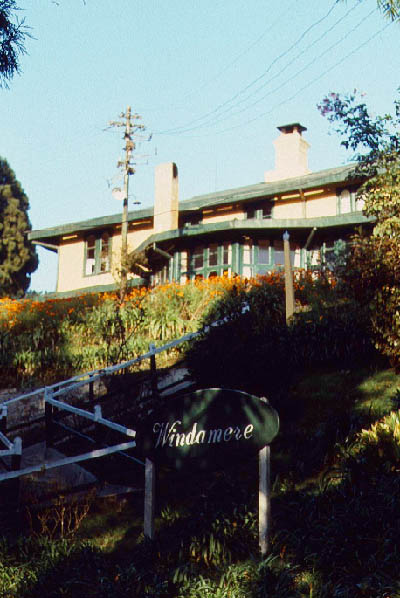
| First find a hotel: Windamere
|
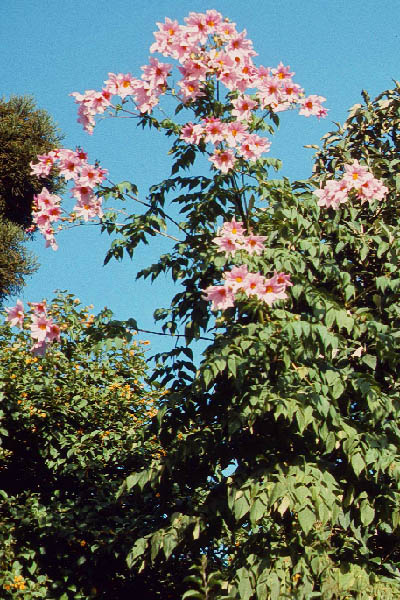
| With nice flowers
|
Yes, the English knew how to live but not necessarily during winter, because this was a mountain summer retreat to escape the heat in Calcutta in the old colonial days. And they wanted to feel home like in old England, so they build their own English houses and gardens, or better let it build by the Indians, who had not only to learn to speak English but also to behave English.
That seemed to be easy to learn but not necessarily to understand. Like our waiter who was dressed in an old Indian uniform but had to serve us with old English etiquette, which he seemed not to have understood, because he was putting his white but dirty handgloved thumb half into our soup while serving dinner. The reason must have gotten lost since Indian independence why Indians were made to wear white gloves: To easily spot a dirty spot on the hand instead to trust just ungloved washed hands.
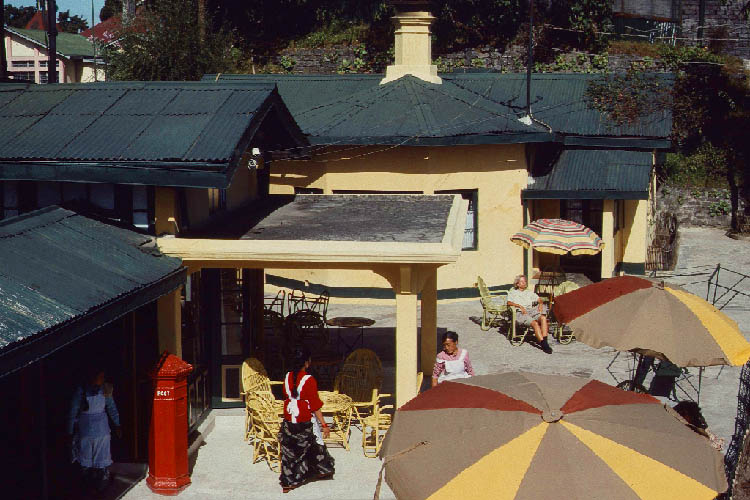
| Sun bathing in the front yard
|
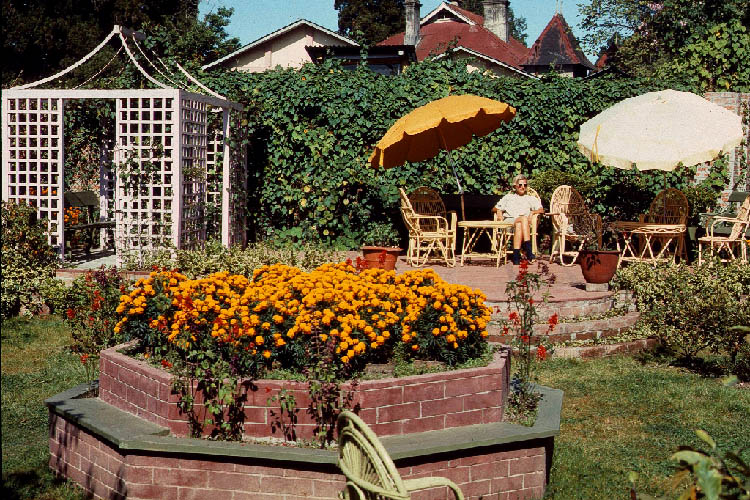
| or relaxing in the back yard
|
During the day it did get a little warmer. Everybody seemed to enjoy sitting in the morning sun. But we walked around in the clear morning air, which was really much better than in Kathmandu. Brigitte did get no asthma attacks anymore. But this also may have been attributed to the new medicine prescribed by an Indian doctor in Ganktok before, which was much better than the remedy recommended by the American doctor back in Nepal.
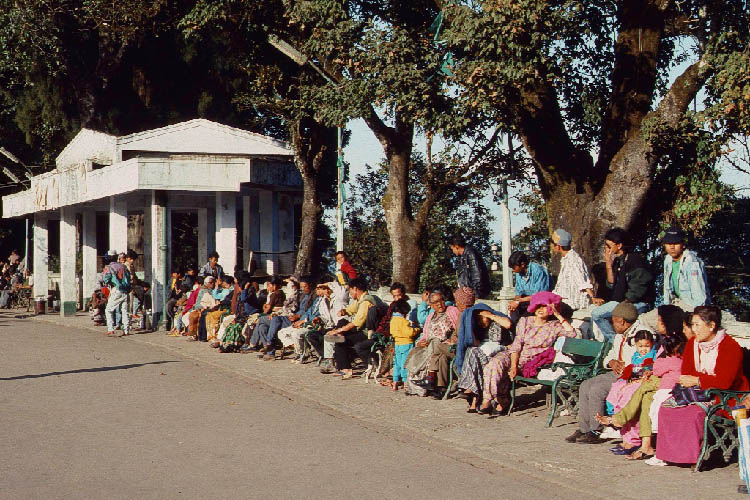
| Everybody likes the sun
|
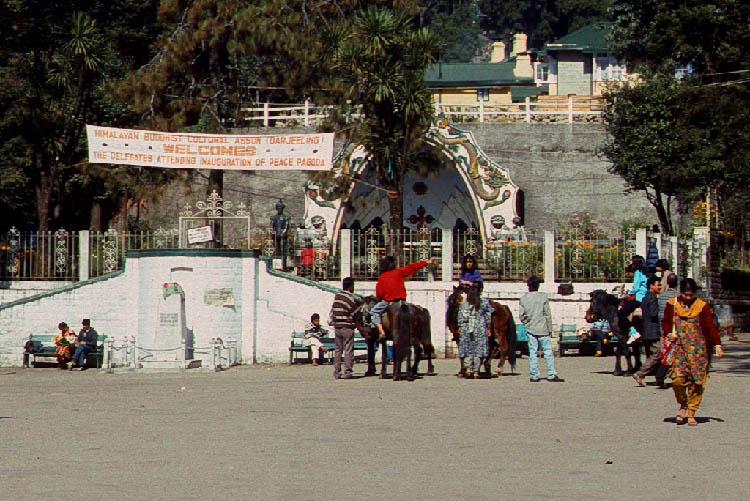
| It's also place for fun
|
Not much traffic either. So we went first to the center where we looked around and were browsing the shops. Many Kashmiri selling all kinds of stuff but no cashmere but Kashmir carpets.
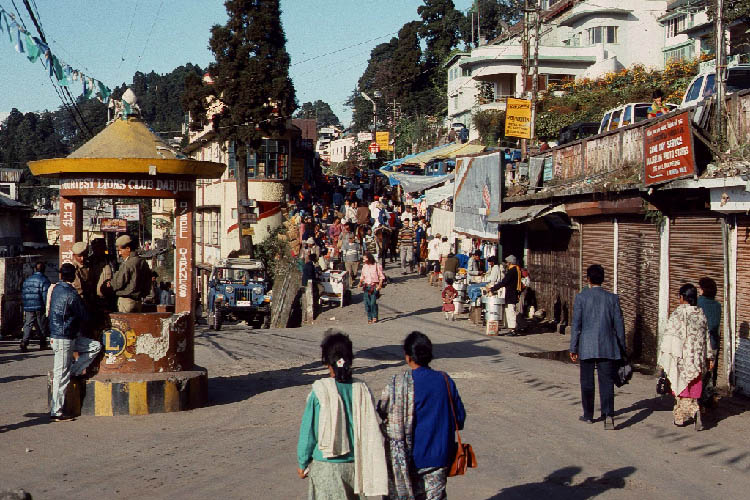
| This is the busiest traffic in town
|
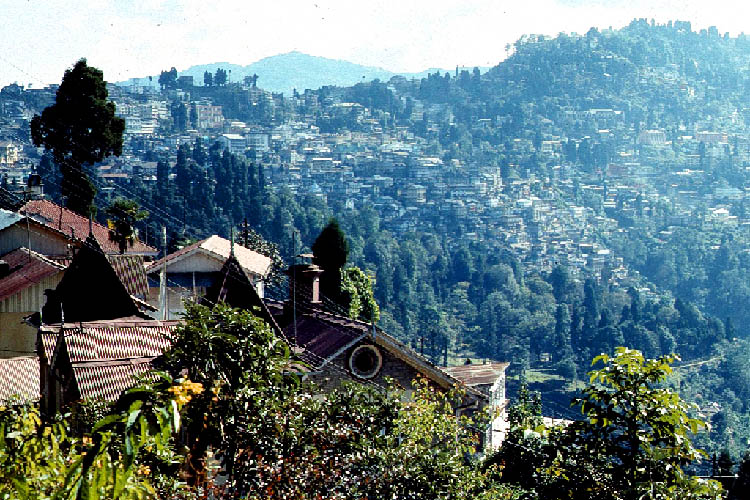
| It's a small but spread out town
|
Visiting a tea plantation is a must. There you see how the tea is processed: from the plucked leaves to the famous Golden Flowery or Broken Orange Pekoe. Also thanks to the British who brought the first tea bush from Assam to this part of India. Now around 25 % of the tea in India is produced in Darjeeling.
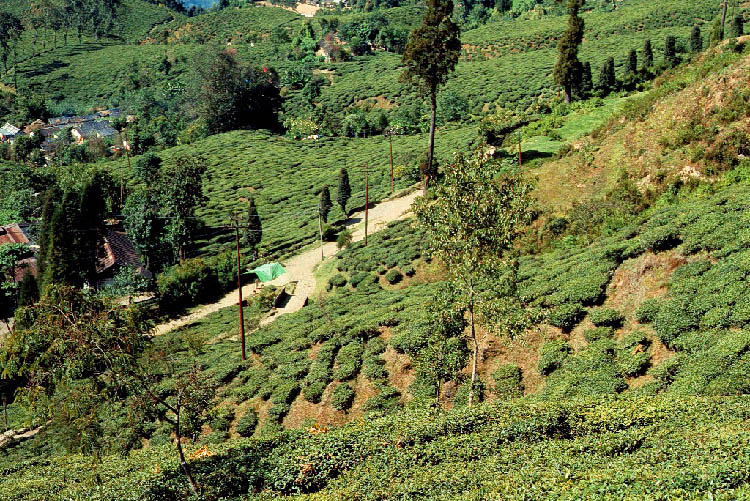
| This is a mountain retreat
|
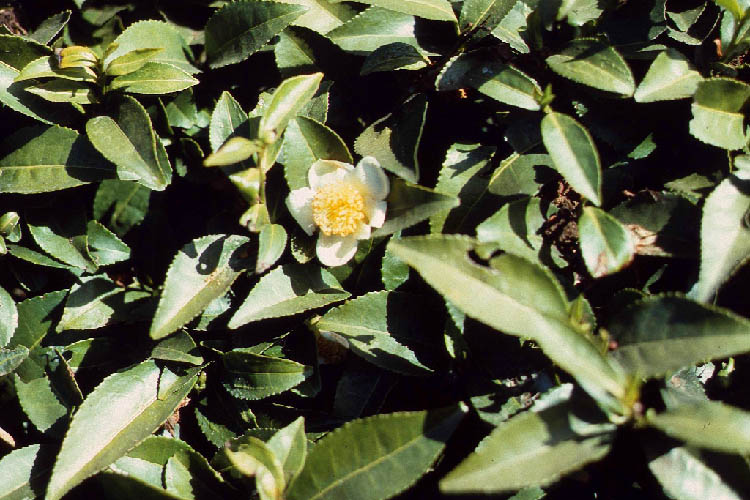
| surrounded by tea plantations
|
It looks all so peaceful here. But there were times when it was not so peacefull around Darjeeling. Formerly part of Sikkim, then invaded by the Bhutanese and subsequently taken over by the Gurkhas from Nepal. The British defeated the Gurkas and gave the area back to the Sikkimese at the beginning of the 19th century. What a righteous and noble action.
Ok, the British were in control now and pursued also their own interests, but they granted security, even by recruiting the Gurkhas now as part of the British army. And there was peace under the British rule until India took over control (same as with Sikkim) after it became independent in 1947. The Gurkhas wanted to have their own state, thus trouble was inevitable (check the internet of what happened).
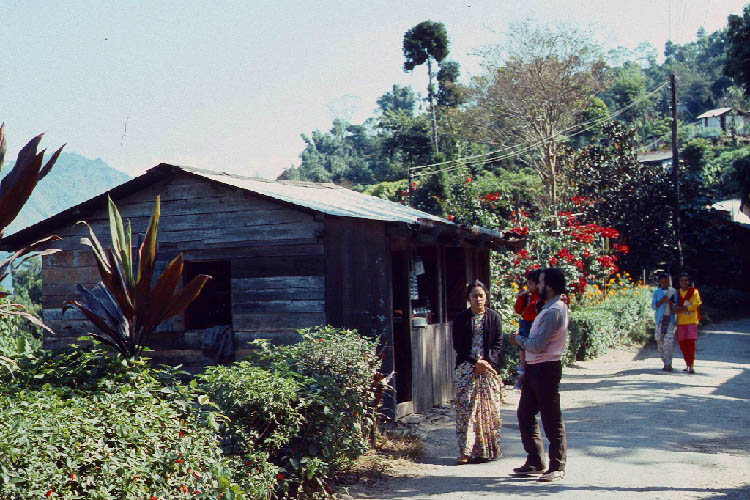
| Walking around
|
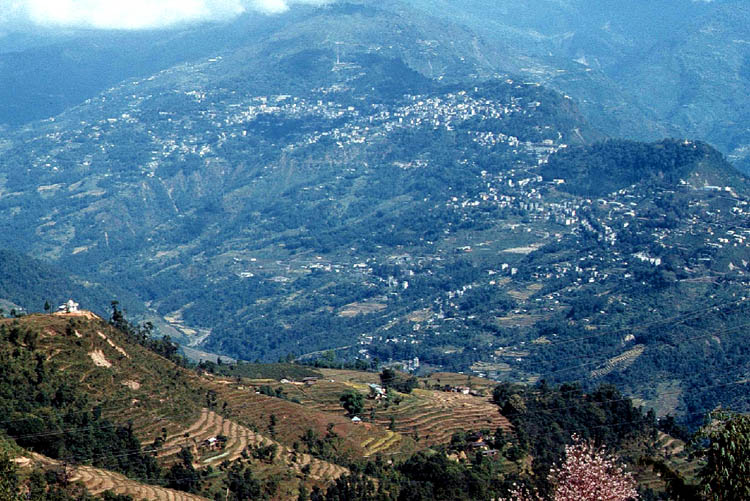
| and admiring the countryside
|
It's also a must to visit the zoo with its supposedly complete collection of the Himalayan fauna. I don 't remember having seen a tiger, wolf or leopard but a black bear looking very sad. Just behind the zoo is the Himalayan Mountaineering Institute on which ground one of the most famous sherpas have been buried: Tenzing Norgay, who conquered the Everest together with Edmund Hillary in 1953 for the first time.

| A bear in the zoo
|
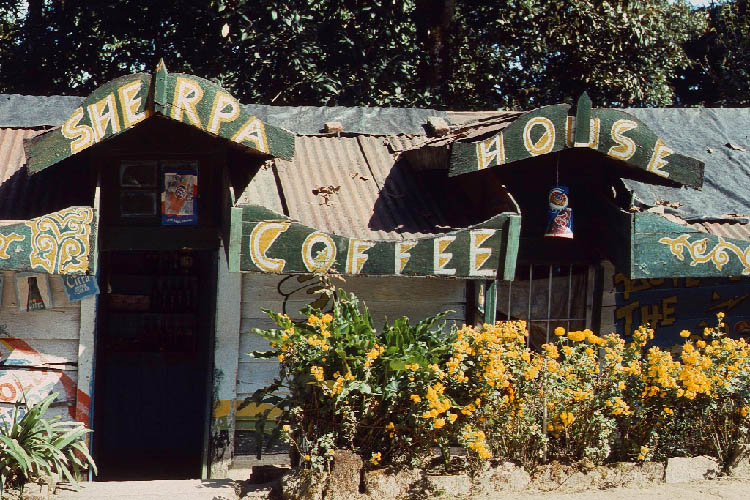
| and a Sherpa's place
|
Also on the grounds of the Himalayan Mountaineering Institute is a somewhat strange telescope installed. At least the text on the plaque is strange and contradictory. A telescope produced by the Veb Carl Zeiss Jena and presented by Adolf Hitler? Veb is the abbreviation of Volkseigener Betrieb (people owned company) and was only used by the communist regime of East Germany after WWII, thus it could not have been presented by Adolf Hitler who died before the end of WWII.
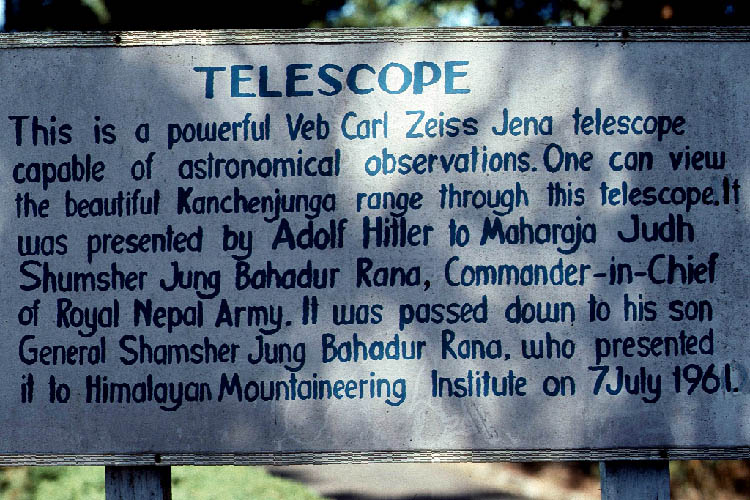
| A telescope from Hitler?
|
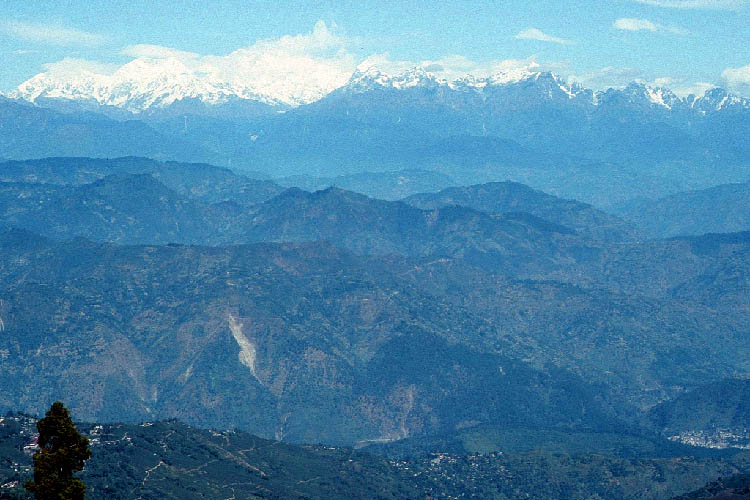
| Good bye, Himalaya
|
We could have joined a trekking tour, but there was no time because we wanted to see Calcutta, not there to die but to survive. But before that we wanted to rest at one of the three best beaches of India, according to some guidebooks.
Puri
And that beach was in Puri in the state of Orissa south of Calcutta. How to get there? Fastest was by air. So we booked the flights in Darjeeling a couple of days before. But we had to take a taxi to get to the next airport in Bagdogra, 90km south of Darjeeling. In Calcutta we had to change the plane to fly to Bhubaneshwar, where we stayed the night at the Kenilworth Hotel (see description after Puri). The next following morning we took a taxi to get to a resort recommended by an Indian colleague, which was the
Toshali Sands
Puri-Konark Marine Drive
Puri, India
Tel: 2888 or 2999
|
located in the middle between Konark and Puri.
The room rate was 53 USD and the meals came up to 25 USD per day (all for two), which was ok. It had a nice garden with many terracotta animal sculptures. Brigitte fell in love with an elephant, which eventually I had to carry all the way back to Germany on my lap so it doesn't break.

| This is our hut
|
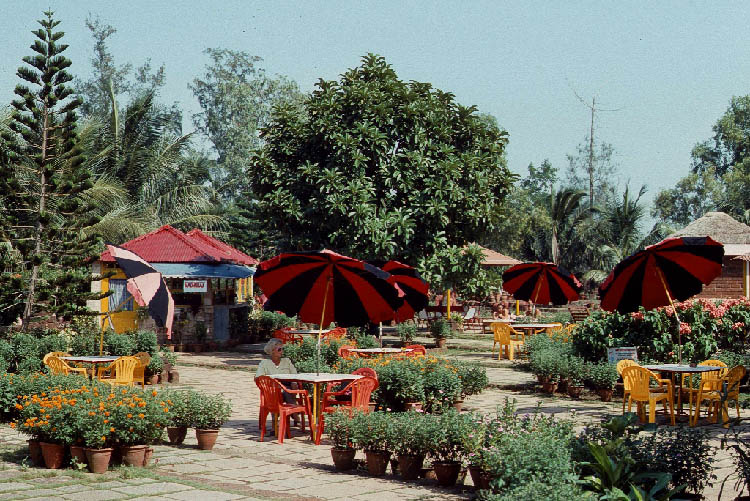
| and this is the garden
|
It was a nice relaxing place and thus we stayed four nights. Brigitte had enough time to write a lot of postcards. Though, they never arrived because they probably disappeared together with the money for the stamps between the hotel reception to the post office in the first place. Never do that again. You better bring your mail personally to the post office and watch the clerk to stamp the stamps so nobody can take them off to sell again. This advice I even read in a guidebook for India.
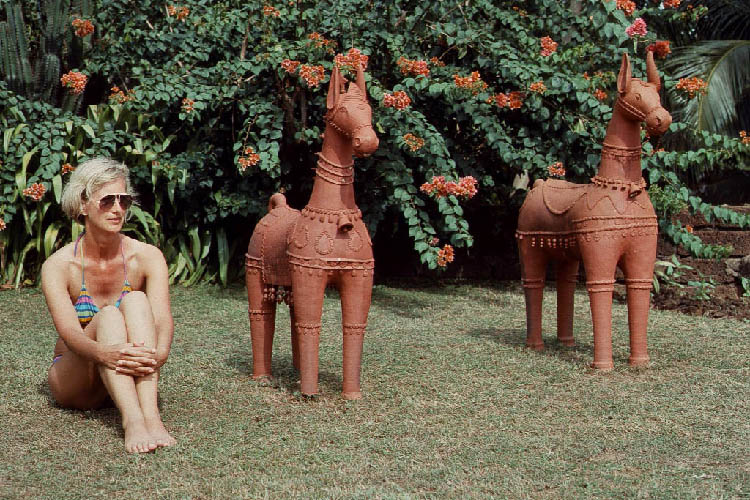
| A lot of terra cotta animals around
|
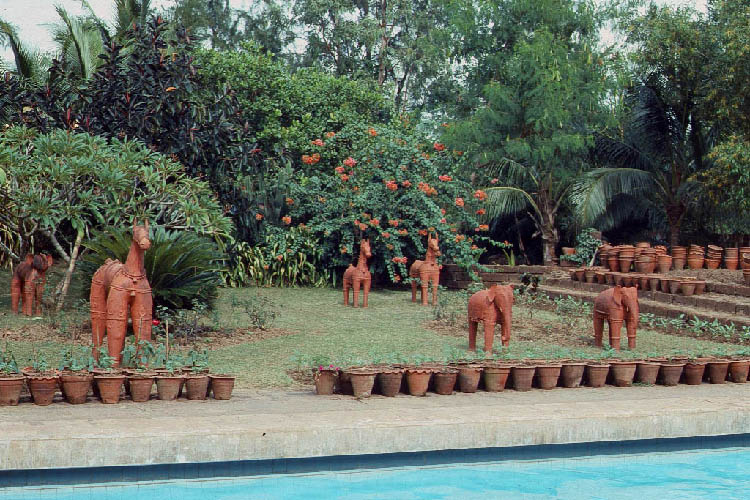
| more pots around the swimming pool
|
This resort was advertised to be at a beach. But where is the beach? The answer was: We can bring you there. So they did: a driver with a car,
the sun umbrella carrier, and a personal guard. After some kilometers on a sandy track through wilderness straight to the east we reached the beach.
It was miles long as far as the eye could see but nobody else was to see. Our servants put out the blanket and put up the umbrella, but not before the sand was cleared of some pile of shit who or whatever made them here.

| But we want to see the sea
|
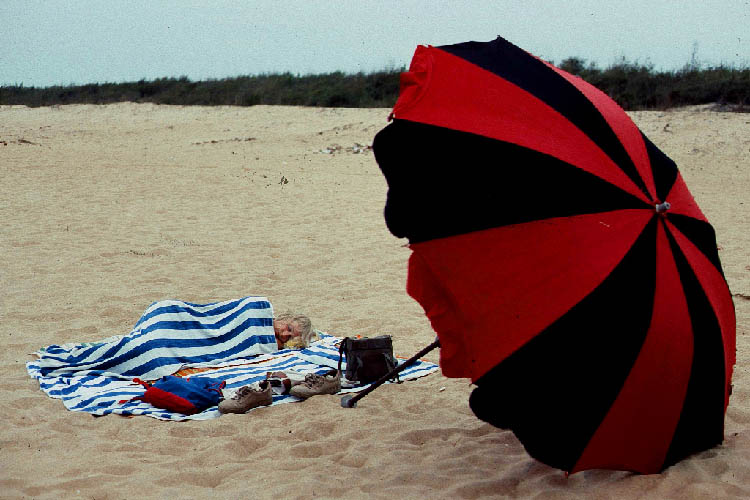
| but Brigitte fell asleep
|
I did not dare to swim.
The sea looked treacherous. Also indicated by a tomb stone in the sand which inscription reads "THOSE WHOM GODS LOVE DIE YOUNG". What comforting words for a young man or woman who may have drowned here.
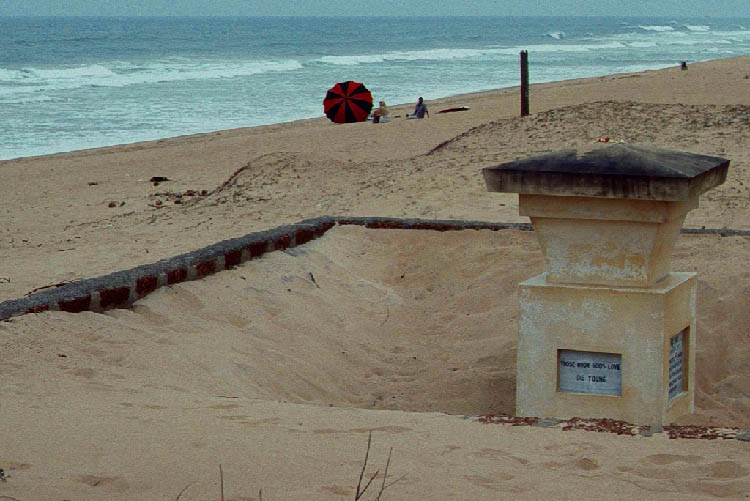
| Somebody chose this place for a loved one
|
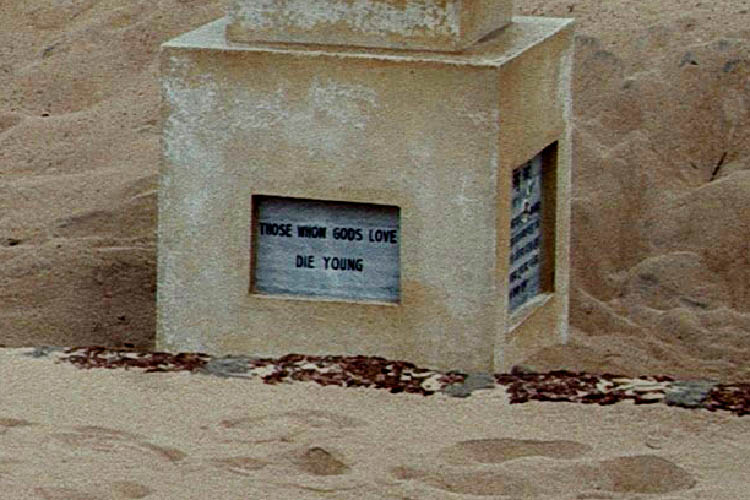
| to commemorate or as a last resting place
|
All the time the two servants were watching us. After a while we just told them to go home and we started to walk along the beach down south. They really did let us go, too, so it was not a NO-GO area.
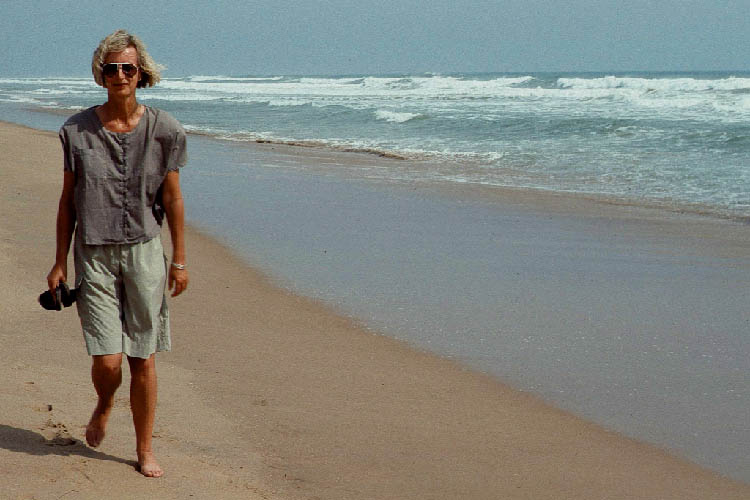
| A God forsaken beach and four miles long
|
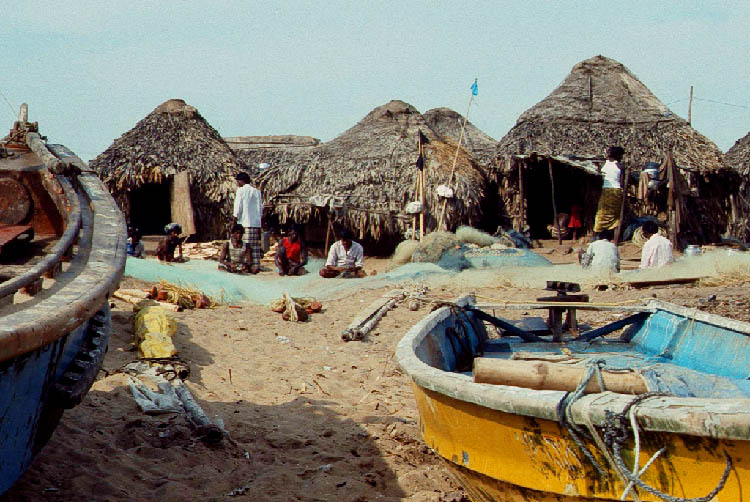
| not for long until we reach this fishing village
|
But after a couple of miles or so, we did reach a NO-STEP area: the beach of a fisher's village which was being used as a public open air toilet. We had to look always down in order not to step on human shit. Maybe it was also intentionally not to clean the shit in order not to look up and seeing people just making it.
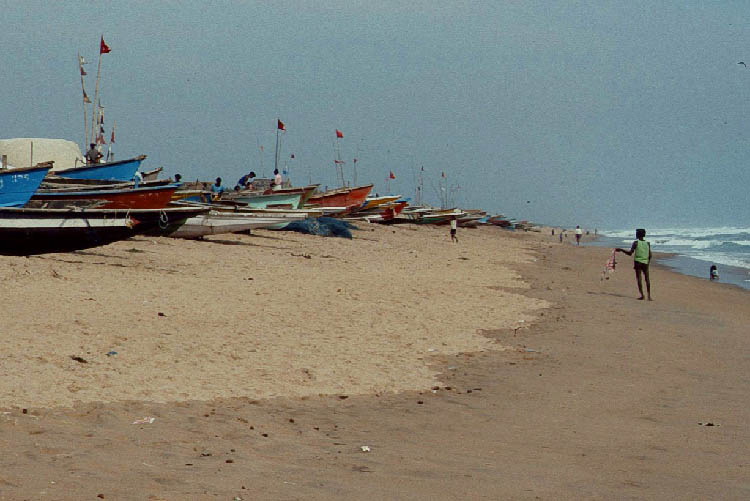
| We had to jump over human shit all along
|
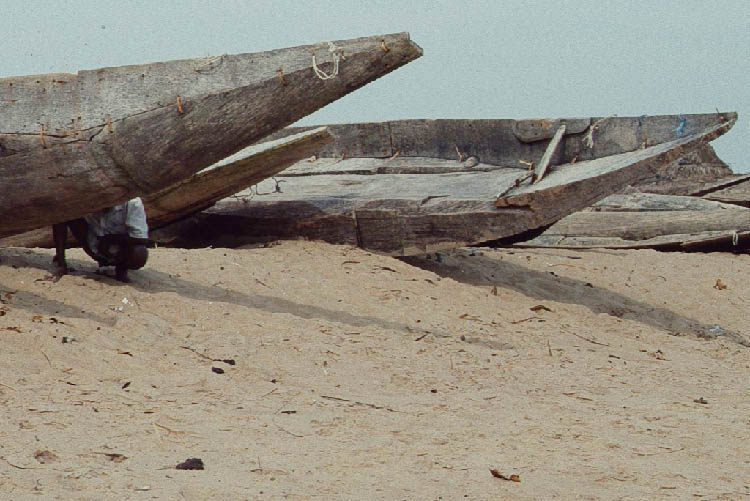
| The fishers don't care while making it
|
Shortly after the fishing village we reached Puri. Believe it or not we made a pilgrimage to the fourth holiest place in India. But as a non-Hindu you are not allowed to enter the most important temples or Mandirs. But you are allowed to buy some bhang. This drug is legalized here but only while worshipping Shiva.
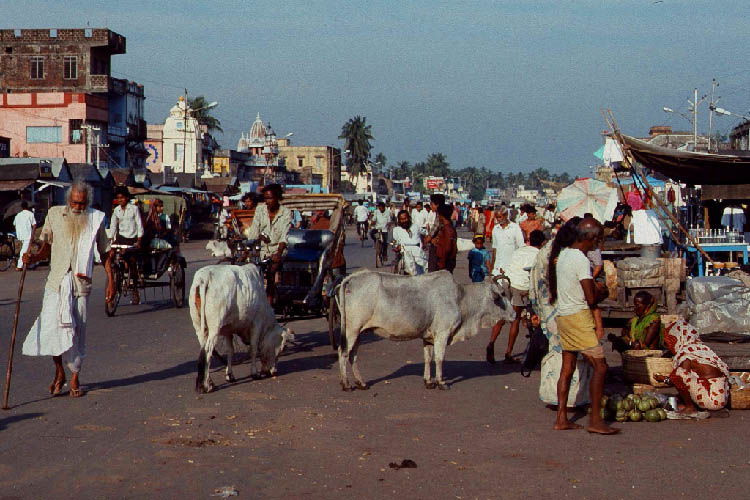
| Then finally we reach Puri town
|

| this is a holy town with holy shit from many cows
|
But we are not here for the weed and looking inside the temples would be the only treat though we could not succeed. So there was no reason to stay any longer. But walking back to Toshali Sands was out of the question but taking some kind of a bus was our final decision.
But there was a real highlight the other day when we were picked up by our taxi driver who brought us here. He promised us before that he will show us around a little more without additional fare before we head back to Bhubaneswar.
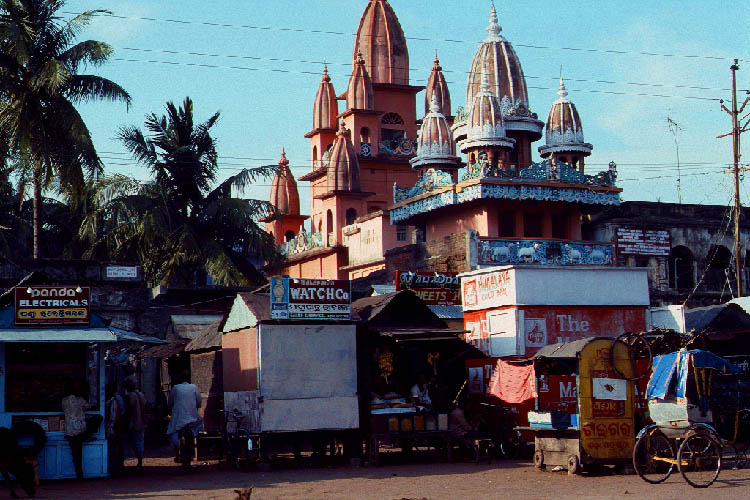
| From a holy Mandir temple in Puri
|
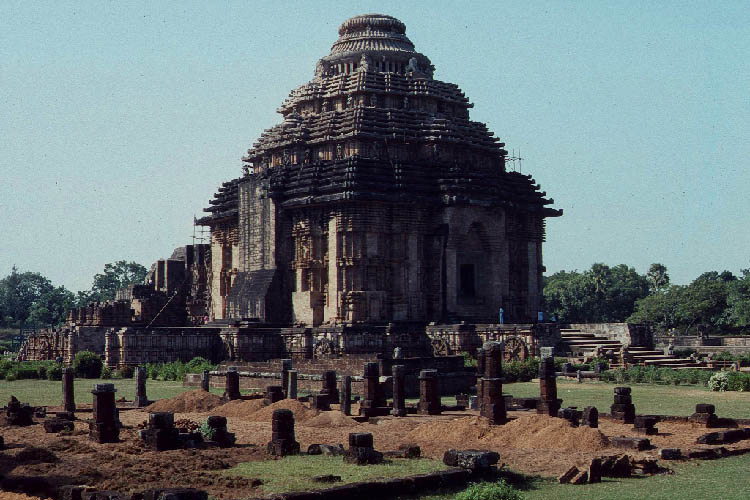
| to the old Sun Temple at Konark
|
And that's the Sun Temple at Konark, one of the most astonishing temples. It was constructed in the 13th century but since then little is known. It may have been built by an Orissan king of Hindu religion to celebrate his victory over the Muslims.
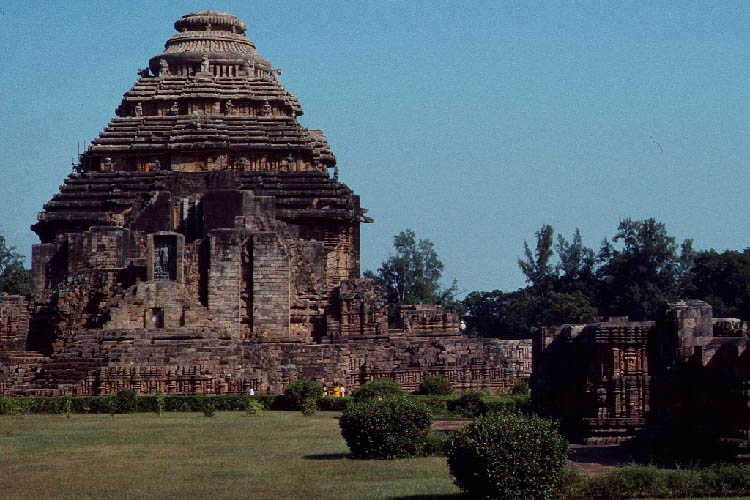
| View from the other side
|
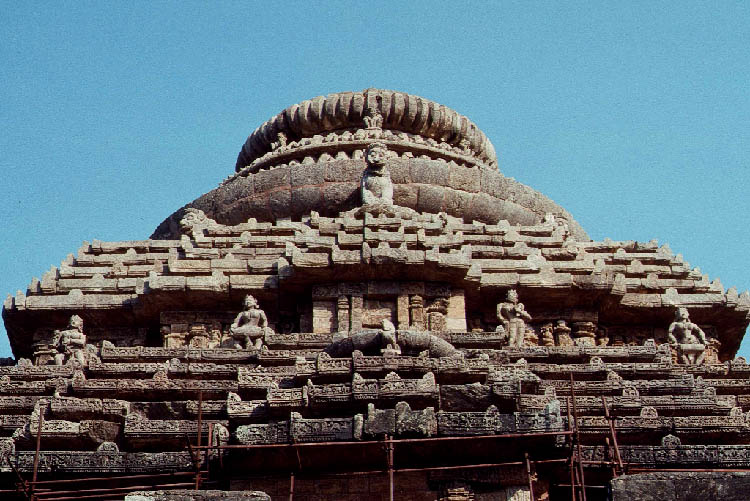
| View to the top
|
The whole temple was conceived as a chariot for the sun god. The base is surrounded by 24 carved gigantic stone wheels higher than me. Seven stone horses are hauling the temple. Despite the size right now it might have been even higher if it had been completed, according to archeologists.
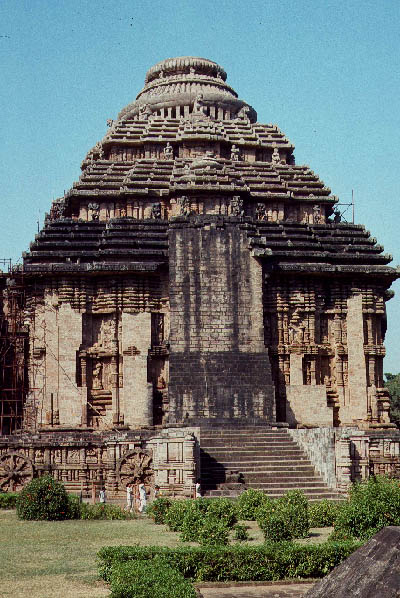
| Built as a chariot
|
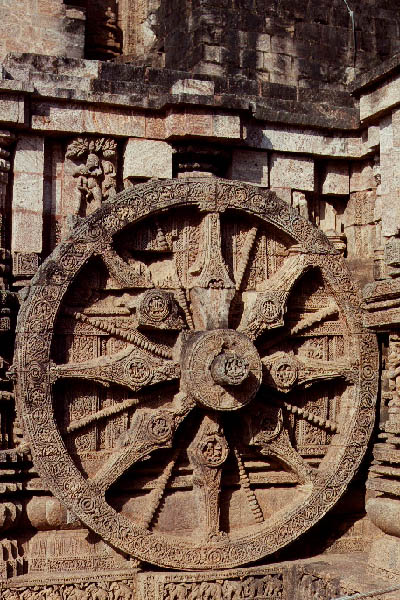
| with wheels all around
|
Higher or not, more interesting are all the sculptures, figures and carvings on the walls, in bays and niches. Even more interesting are the many erotic themes, beside horses, elephants and deities, of course. Take a look yourself at the following pictures. If you want to see more of these then visit Khajuraho in my travel report of India 2004.
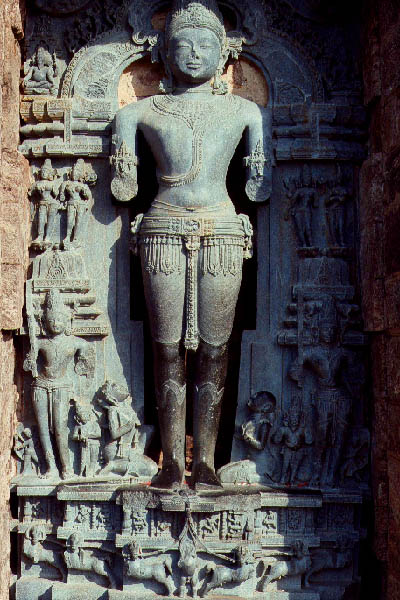
| Carvings, carvings everywhere
|
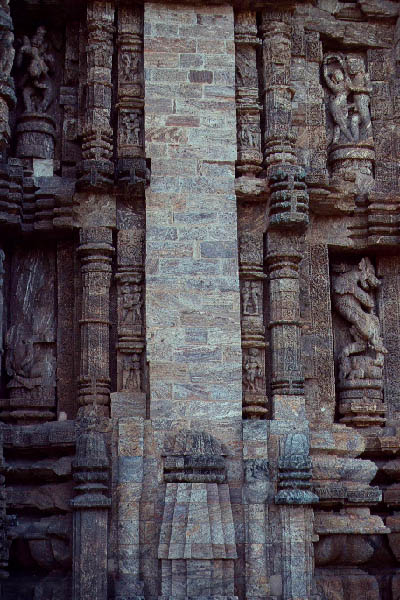
| Almost no free space is available
|
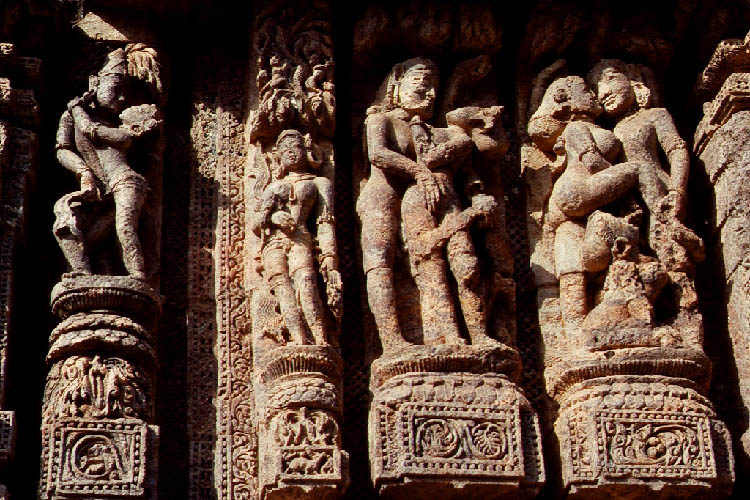
| But free love is all around
|
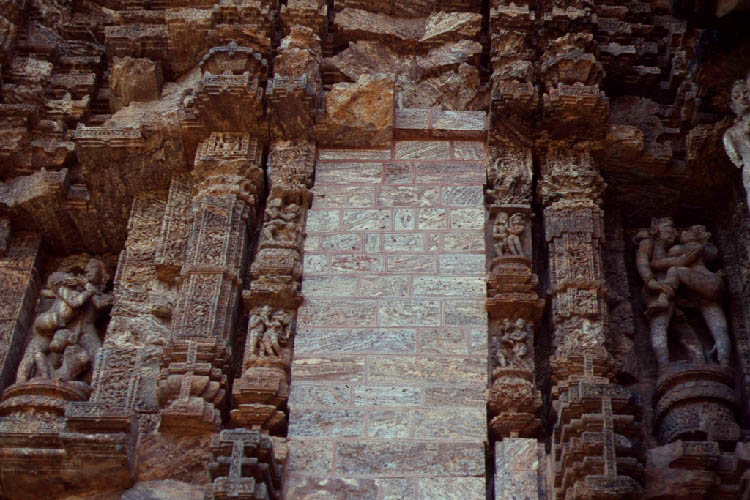
| With many loving couples
|
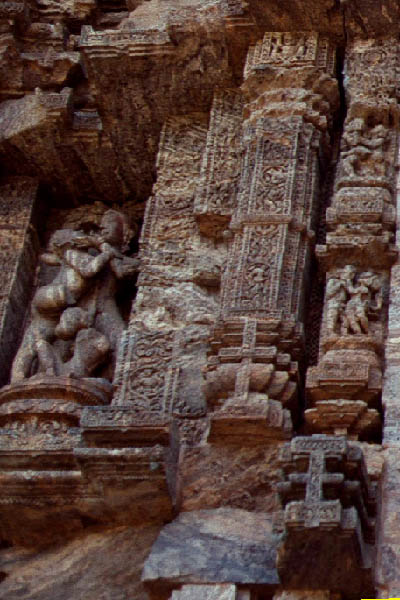
| Do you want
|
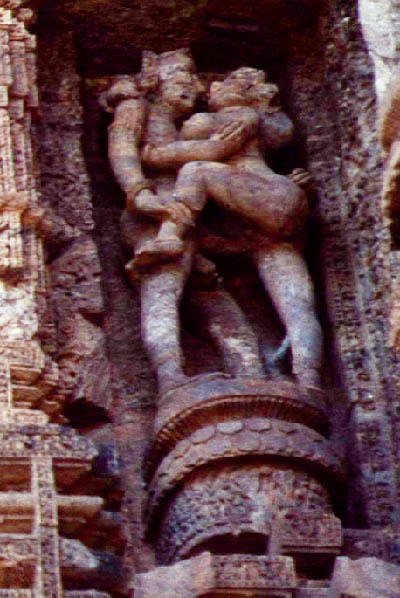
| a close-up look
|
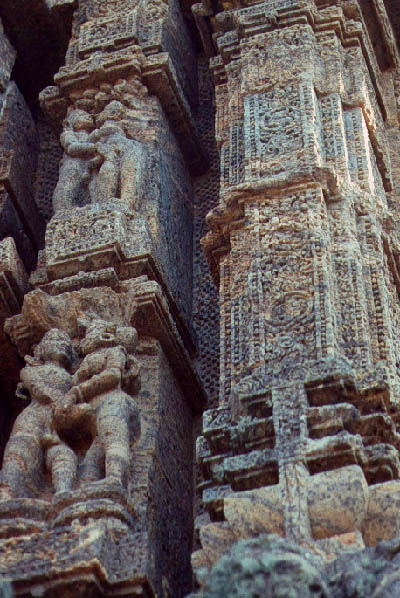
| One over the other
|
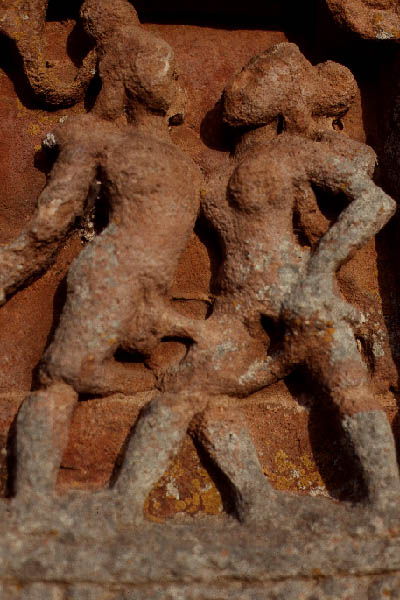
| This is an old couple
|
The whole complex does not only consist of the chariot but also some other temples. And the remnants of more walls in the ground and some ruins indicate that there were many more buildings in the old days.
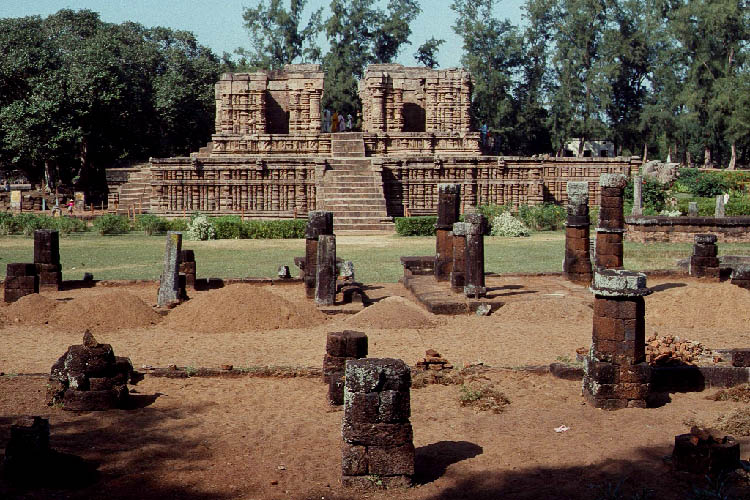
| If the previous pictures were too pornographic
|
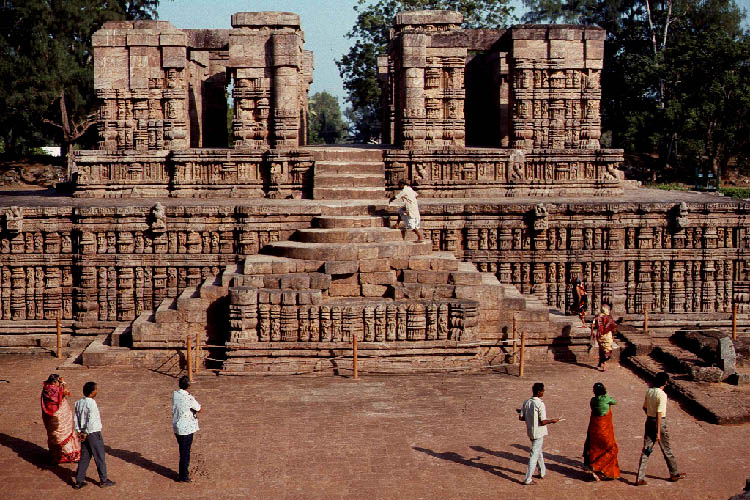
| then this is for one who wants more aesthetic
|
Bubaneshwar
After Konark we continued to Bhubaneswar. On the way we stopped at another fine temple. I do not remember which one because there are many left and right along the road south of the city .
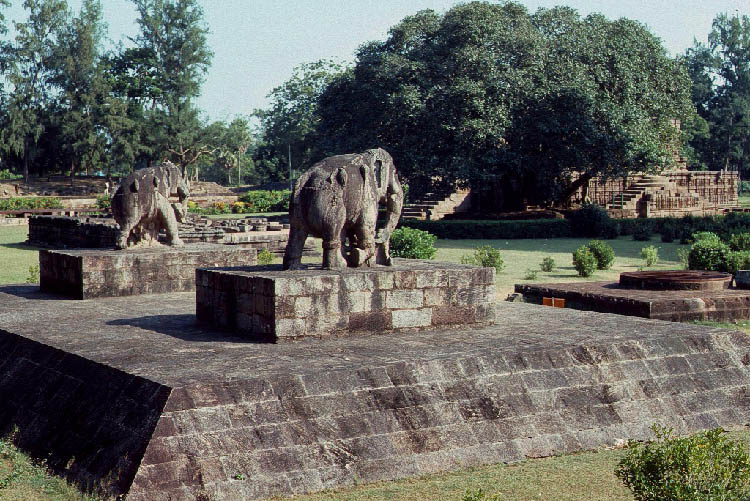
| Many elephants carved in stone there are
|
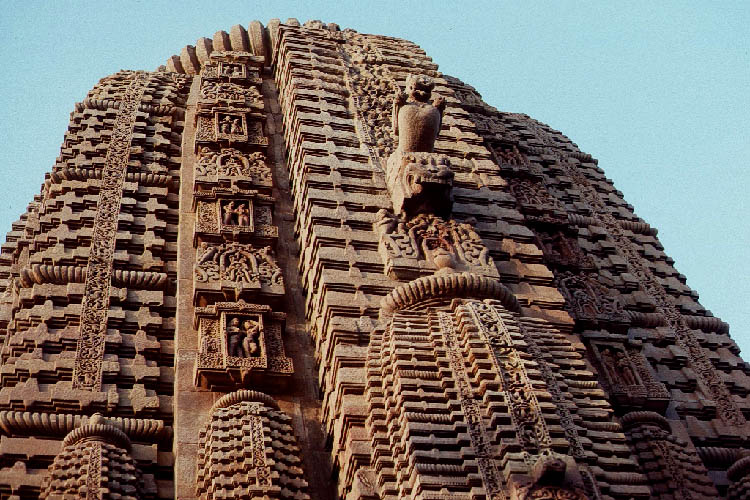
| We reached another temple just before Bubaneswar
|
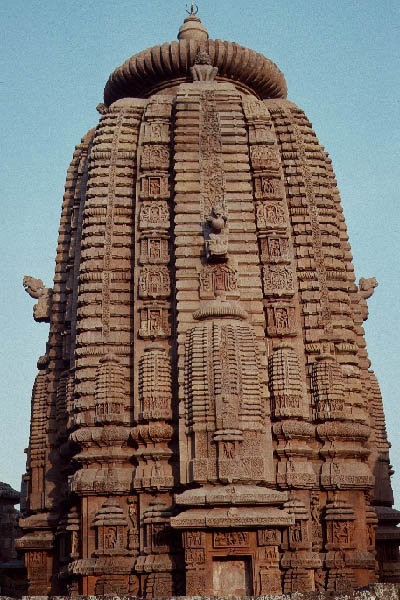
| Imposing temple with a lot of carvings
|
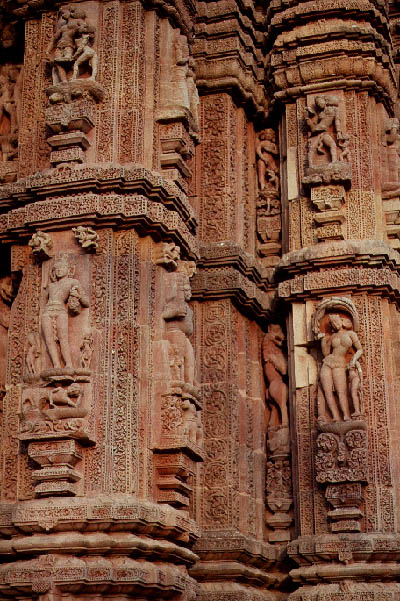
| Also with many beautiful ladies
|
Finally we arrived in Bhubaneswar again. The taxi driver dropped us at our hotel where we stayed before, the
The Kenilworth Hotel
86/A-1, Gautam Nagar
Bhubaneswar, India
Tel: 54330 or 56543
|
which was a nice place in the middle of the city The room rate was 32 USD. It also had a good restaurant. The dinner consisting of soups, prawns, dessert, juice and beer came up to 15 USD for the two of us.
Next morning we went to the airport. The flight to Calcutta we had already booked in Darjeeling. And we were pretty sure that we fly on time to be in Calcutta with two night's contingency. But when we tried to check in, we were told that the flight is delayed until the afternoon.
What to do till then. We deposited the luggage (including our terra cotta elephant) at the airport and took a taxi to the famous Udaigiri & Khandagiri Caves, around six km from the airport.
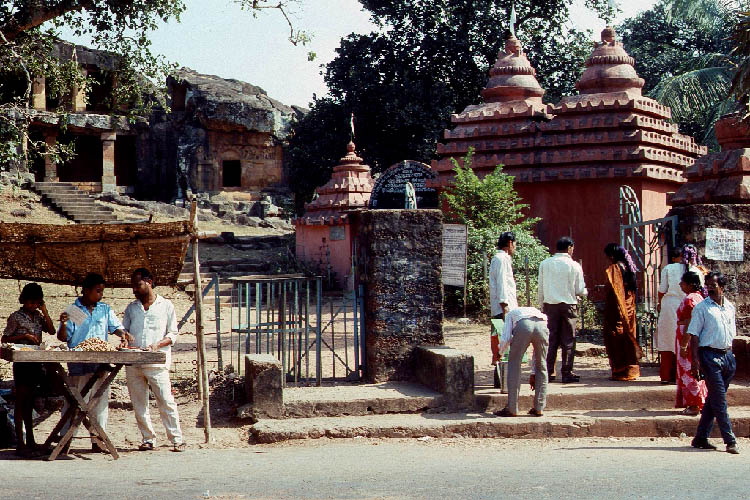
| Entrance to the caves
|
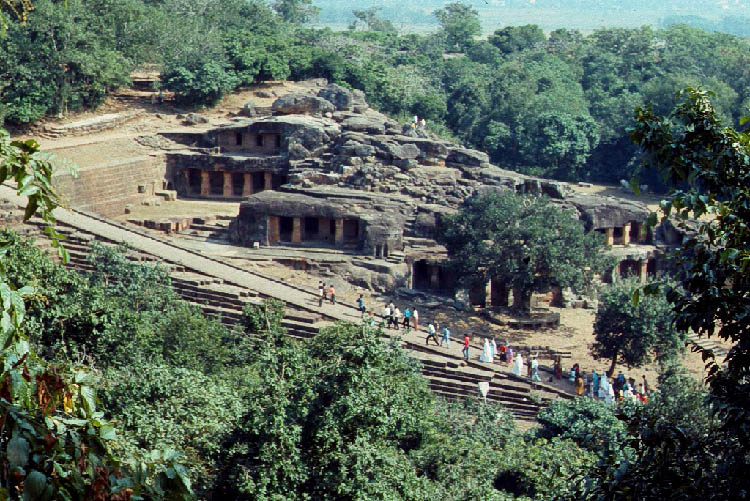
| View to the caves
|
There are many caves, small and larger ones. They are thought to have been chiseled out for Jain ascetics around the first century BC. Many walls show all kinds of carvings depicting people and animals.

| Who has once lived here?
|
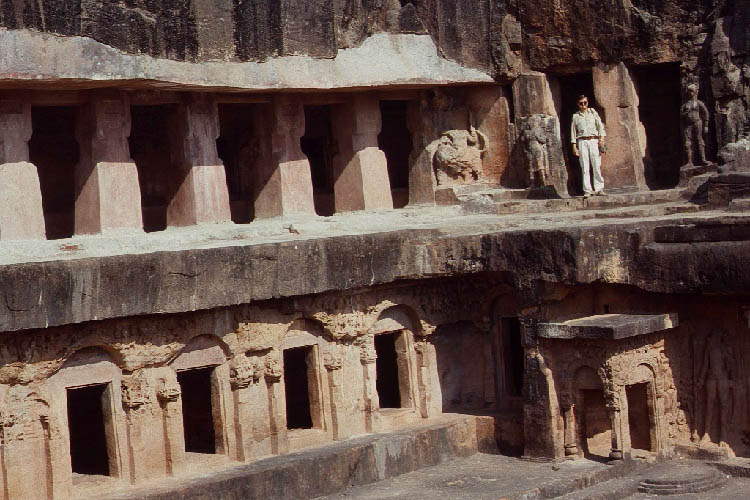
| The rooms are all for rent now?
|
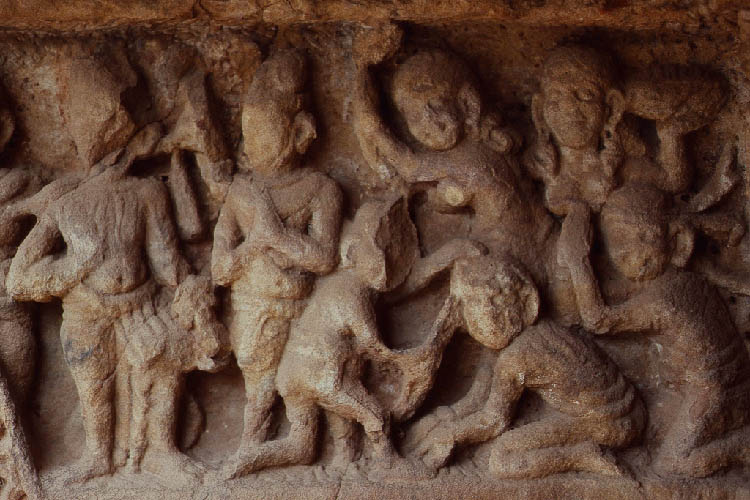
| Carvings inside
|
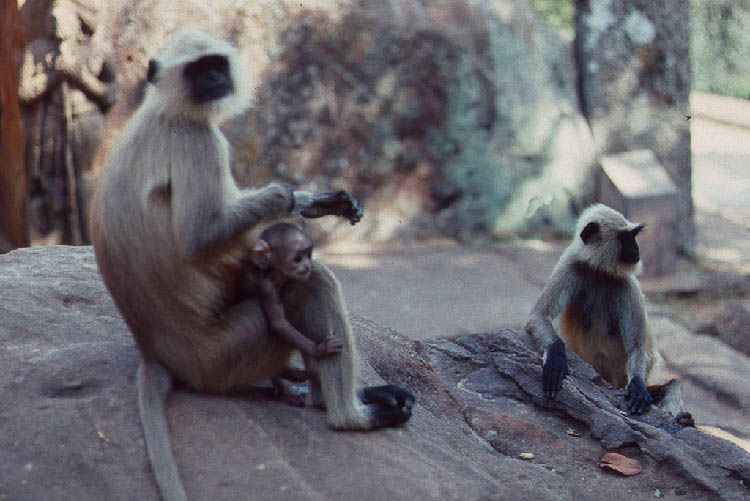
| Monkeys outside
|

| This looks like an animal
|
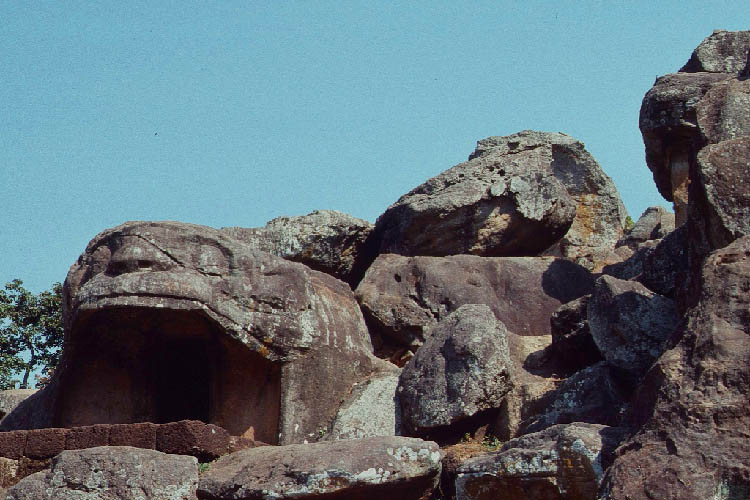
| This one with a big mouth
|

| It's not dangerous as you can see
|
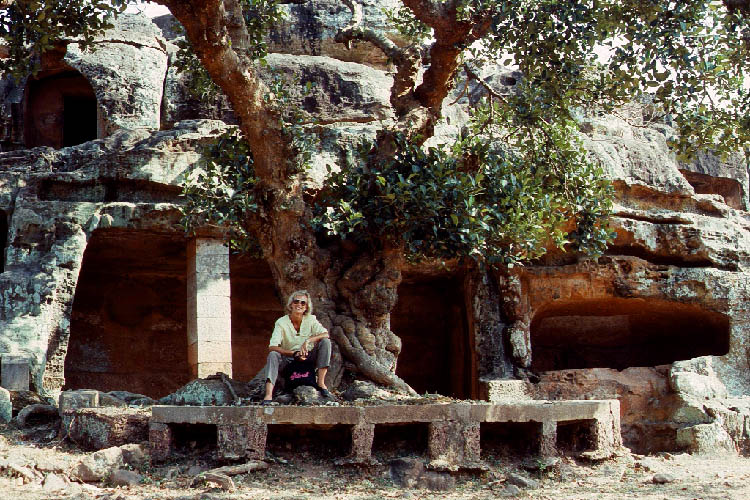
| Now it's time to relax under a tree
|
After that interesting sight-seeing tour we went back to the airport at the agreed time where we were told that our flight has been canceled. Fantastic. How to get to Calcutta now fast so we don't miss our flight to Dhaka.
No other means of transport than the train. We rushed to the train station where I couldn't get through the crowd to the ticket counter. Yes, ok, the next train to Calcutta is scheduled to leave soon. I went to the station master's office. Full of people, too. The station master however saw me in distress and came to me. He was very kind and helped me to get two tickets right away. We left the crowd behind and boarded the train. And what a surprise, everybody did get a seat and nobody crowded the aisle.
Calcutta
Early morning before dawn we arrived in Calcutta's main station. During the taxi ride through the city it looked like the dawn of the apocalypse. The air was a hazy confusion probably saturated with carbon dioxide and other fumes. But no cars were moving except our taxi. No people were moving either, but lying all over on the sidewalks. Ok, they were not dead I assumed, because Mother Teresa would already have them removed. So they must have been just sleeping there, because they were pavement dwellers, a big proportion of Calcutta's population.
WELCOME TO CALCUTTA
Ok, it did sound cynical, but it was not meant that way. And by the way, that was the only gloomy thing we experienced in this city. Ok, we did not visit any of the many slums, so there was no challenge for Brigitte as intended by me to test her ability to travel around under the worst probability. She already had passed the test during this trip except for her malady.
I do not remember the name of the middle class hotel we stayed in. It could have been a Kenilworth again. It was located in the Chowringhee area and in walking distance to the sights as shown in the following photos. Take a look and you will be surprised about some beautiful parks and buildings.

| Oh, Calcutta
|
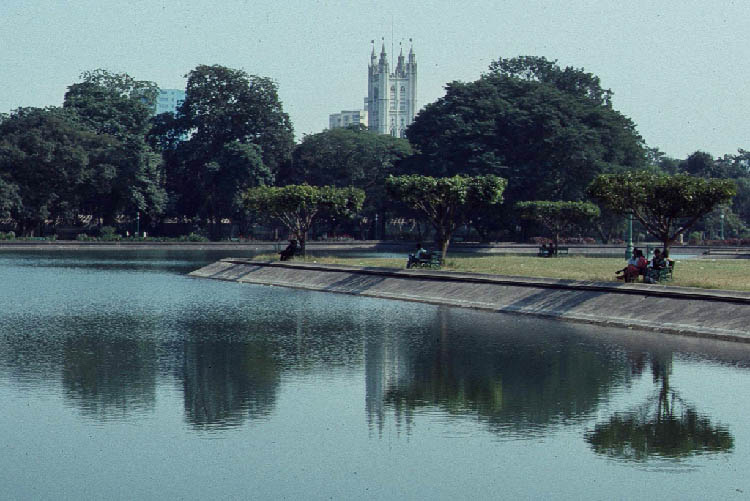
| You are a jewel
|

| A leftover from the British
|
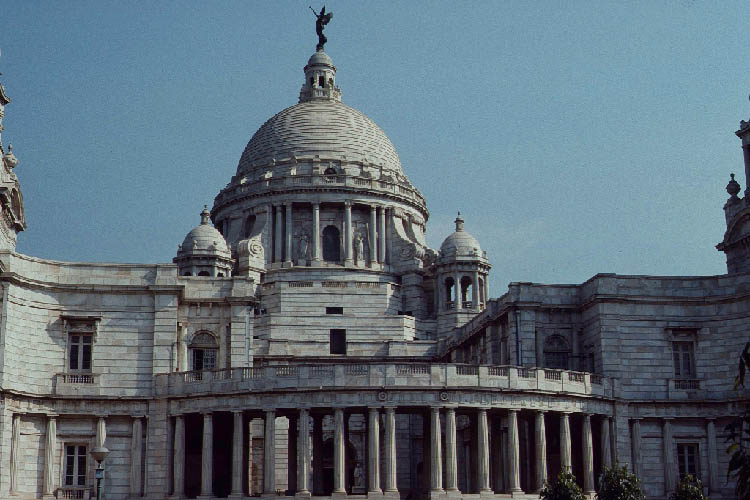
| the Victoria Memorial
|

| Fort William from the British
|
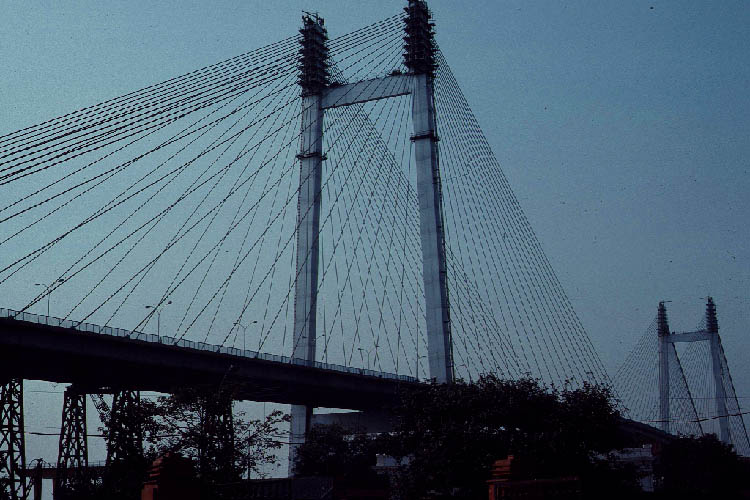
| A modern bridge built by Indians
|
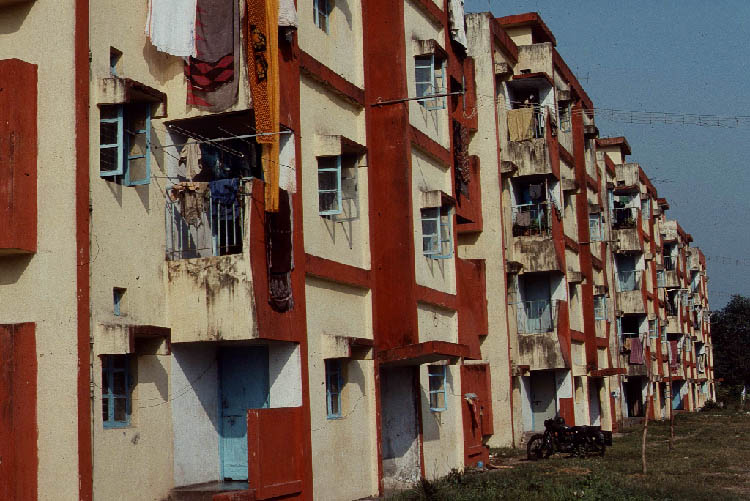
| India needs a lot of flats for their growing population
|
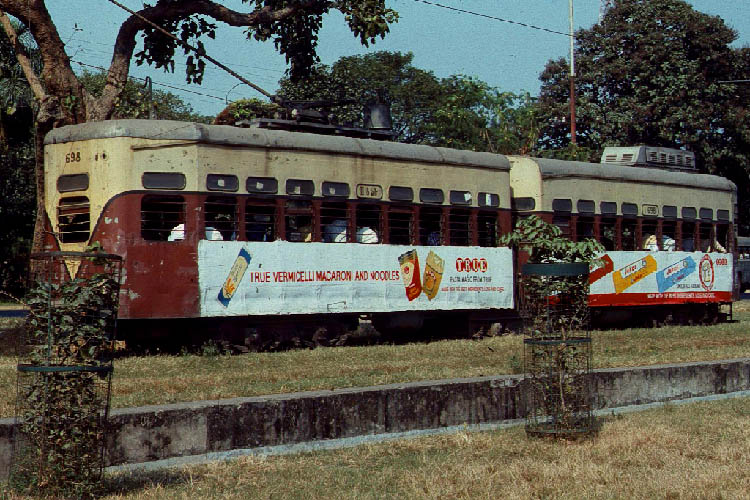
| This tram will not be enough for all the people in Calcutta
|
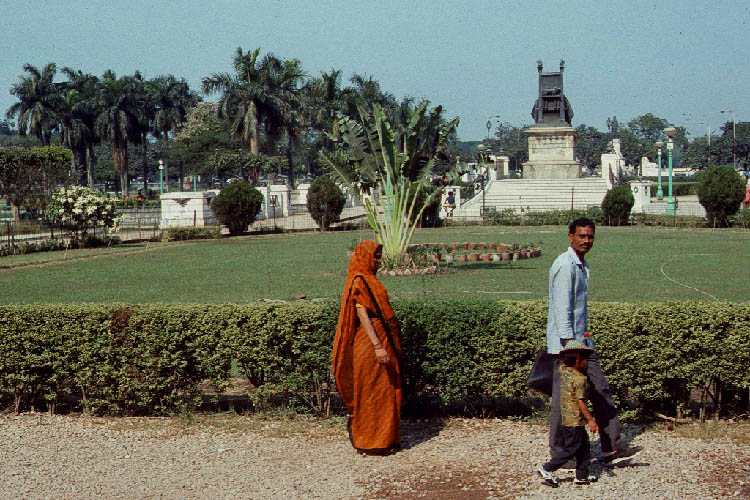
| Maybe some day they have the one-child policy
|
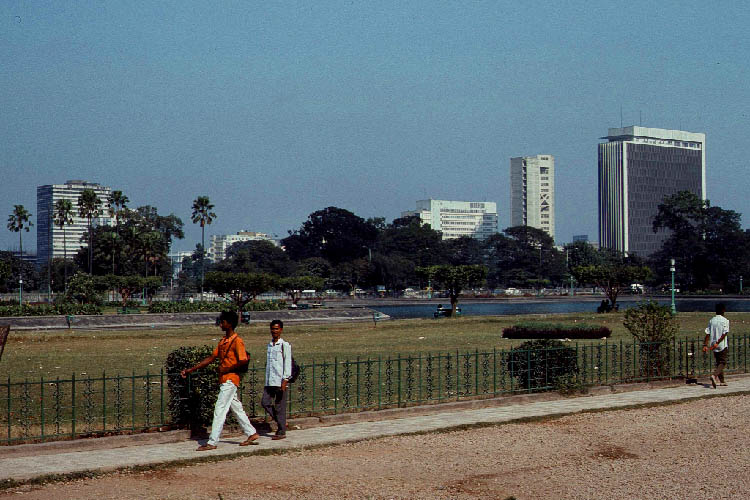
| Calcutta, Good Bye
|
That's actually all we saw of Calcutta besides the Biman Airline office, where we had to reconfirm our flights for the next day. More to reconfirm our reconfirmation I did from the Toshili Sands in Puri, but feared that it was not registered as such. And that really was the case. So I was right not to trust.
I also could not trust Indian Airlines at the airport where I did get a Visa Card Credit Statement for the canceled flight from Bhubaneswar. Nothing happened for the next three months. I did get my money back only after I have sent a copy of the Indian Airline statement to Visa.
Finally, our flight from Calcutta left on time and the stopover in the airport of Dhaka was ok even if we had to sleep on the bench until the final call for the final leg. But that' s the way to travel cheap. I need some physical strain beside some cerebral challenge as part of a survival training before getting back to the comfortable office desk which is no good for the back.
Ok, that was Calcutta and northern India, though only a very small part of it. I could have seen and done a lot more. Also I could have written more. If you want to know more about all the places I have visited, then just look up any of the many guidebooks or in the internet.
| 